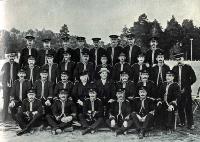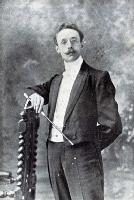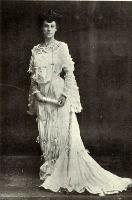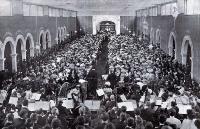Music At The Exhibition
"Good music was one of the best features of the Exhibition, a feature that did a great deal to brighten the impressions … carried away by visitors".1 Musical entertainment at the Exhibition took place both outdoors and in the Concert Hall. Audiences could enjoy performances by a variety of groups such as:
- Orchestras
- Chamber music
- Organ recitals
- Brass bands
- Pipe bands
The Exhibition Orchestra
It has been suggested that "In retrospect the [Exhibition] Orchestra proved to be one of the highlights of the Exhibition".2 The Exhibition Orchestra, the first professional orchestra in New Zealand, was led by Alfred Francis Hill. It was only after some debate and controversy, that the Government agreed to appoint the "temperamental and virile"3 Hill as conductor and to pay for 56 players. Hill selected his musicians from both Australia and New Zealand. They included 5 women (3 violinists and 2 harpists, one of whom also acted as pianist), 7 Italians and 3 Germans. The leader was George Weston and the sub-leader Cyril Monk, both from Australia. By all reports the players found Hill "an easy conductor, free, friendly and attractive".
For the opening ceremony, Hill composed an Exhibition Ode, with words by Johannes Carl Andersen. John Eldon Gorst wrote that "It was a very impressive performance … I was informed by competent critics that the music was of first-rate quality". 4 Certainly it was very enthusiastically received, and Hill himself considered it his finest work so far. From then on, the Orchestra played twice a day, the programmes covering a wide range of music, from symphonies, overtures, suites and ballet music to works for piano and orchestra, violin and orchestra and chamber music groups. Many composers, including Wagner, had never before been heard in New Zealand.
At first audiences were very small (The Press thought that poor advertising was at least part of the problem, while the Star bewailed the musical taste of Christchurch citizens, who seemed to prefer the fascination of Wonderland to the attraction of a first-class orchestra), but in the New Year, as word of the high standard of the performances spread, attendances grew.
In the last month of the Exhibition, the Concert Hall was regularly crammed with upwards of 1500 patrons. As the Star noted in an editorial, due solely to its own merits, the Orchestra had become for many people the principal attraction at the Exhibition. It was not financially successful at one stage the press referred to "Hill’s Brigands" in commenting on the cost to the taxpayer but its educational value was not questioned. Journalist and critic Charles Nalder Baeyertz wrote that its greatest achievement was in bringing the public around to serious classical music: "it was a very triumph for instrumental music of the highest type".5
The Besses o’ th’ Barn
The second major highlight of the musical programme was the performances of the famous Lancashire working-class brass band, the Besses o’ th’ Barn. This 36-man group, which had won every important band contest in Britain, played every afternoon and evening during its 2 two-week seasons, from 9 January and 28 February, either indoors or at the sports ground. The conductor was Alexander Owen, and according to one critic, his magnificent concerts "taught us new musical language". At the band’s farewell concert on 14 March, Mr Siddall of the Woolston Brass Band presented Owen with a gift as a mark of the esteem in which he was held by the bandsmen of Christchurch. The Besses themselves said they had had "a storming good time" and the appreciation of audiences had been as high as they received at Home.
Other Musical Entertainment
The Besses o’ th’ Barn and the Exhibition Orchestra were by no means the only show in town. Visitors could enjoy performances by groups such as the Christchurch Musical Union, and the Auckland Orchestral Society. The Society was sponsored by the Auckland Exhibition Commissioner, Henry Brett and gave 3 concerts in late January. The conductor at these concerts was Johannes Wielaert with soprano Madame Wielaert as the soloist.
Other classical music could be heard at chamber music concerts, and at organ recitals given by John Christopher Bradshaw, the Christchurch Cathedral organist. Further musical entertainment was provided through brass band and pipe band contests.
Exhibits of both British and New Zealand-made musical instruments were also a major feature at the Exhibition; Booseys of London, for example, whose products were used by the Besses o’th’ Barn, sent a complete set of military and brass instruments as well as a large selection of printed music.
![]()
Related photos
Sources
- Cowan, J. Official record of the New Zealand International Exhibition of Arts and Industries held at Christchurch, 1906-7. Section XIII, page 376-379
- Thomson, J.M. "‘A triumph for instrumental music of the highest type’: From the Orchestra to the Besses o’ Th’ Barn Band". In J.M. Thomson (Ed.), Farewell colonialism : the New Zealand International Exhibition, Christchurch, 1906-07
- "The Exhibition Orchestra" The Star, 11 April 1907, page 2
Related links
- Philip Jane, An Historical Survey of the Establishment of an Orchestral Tradition in Christchurch to 1939, thesis, University of Canterbury.
Biographies of Musicians
- Alfred Francis Hill in the Dictionary of New Zealand Biography
- Henry Brett in the Dictionary of New Zealand Biography
- John Christopher Bradshaw in the Dictionary of New Zealand Biography
- Johannes Carl Andersen in the Dictionary of New Zealand Biography
- John Eldon Gorst in the Dictionary of New Zealand Biography
- Charles Nalder Baeyertz in the Dictionary of New Zealand Biography
Footnotes
- [1] Cowan, J. Official record. page 376
- [2] Thomson, J.M. "‘A triumph for instrumental music of the highest type’: From the Orchestra to the Besses o’ Th’ Barn Band". In J.M. Thomson (Ed.), Farewell colonialism, page 87
- [3] Thomson, J.M. "‘A triumph for instrumental music of the highest type’: From the Orchestra to the Besses o’ Th’ Barn Band". In J.M. Thomson (Ed.), Farewell colonialism, page 86
- [4] Thomson, J.M. "‘A triumph for instrumental music of the highest type’: From the Orchestra to the Besses o’ Th’ Barn Band". In J.M. Thomson (Ed.), Farewell colonialism, page 85
- [5] Thomson, J.M. "‘A triumph for instrumental music of the highest type’: From the Orchestra to the Besses o’ Th’ Barn Band". In J.M. Thomson (Ed.), Farewell colonialism, page 91






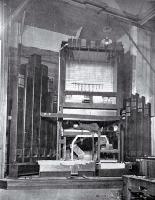
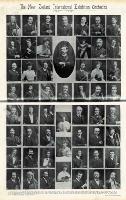
![The pipe bands in the massed display [1907]](/Heritage/Photos/Disc20/Thumbnails/IMG0007.jpg)
